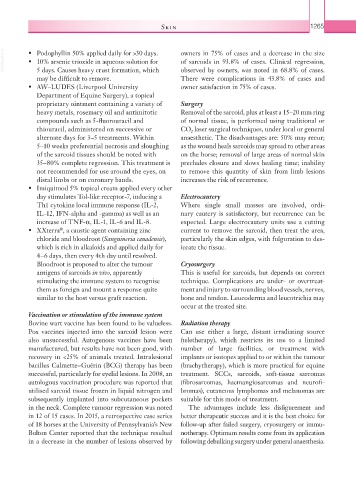Page 1290 - Equine Clinical Medicine, Surgery and Reproduction, 2nd Edition
P. 1290
Skin 1265
VetBooks.ir • Podophyllin 50% applied daily for >30 days. owners in 75% of cases and a decrease in the size
• 10% arsenic trioxide in aqueous solution for
of sarcoids in 93.8% of cases. Clinical regression,
5 days. Causes heavy crust formation, which
may be difficult to remove. observed by owners, was noted in 68.8% of cases.
There were complications in 43.8% of cases and
• AW–LUDES (Liverpool University owner satisfaction in 75% of cases.
Department of Equine Surgery), a topical
proprietary ointment containing a variety of Surgery
heavy metals, rosemary oil and antimitotic Removal of the sarcoid, plus at least a 15–20 mm ring
compounds such as 5-fluorouracil and of normal tissue, is performed using traditional or
thiouracil, administered on successive or CO laser surgical techniques, under local or general
2
alternate days for 3–5 treatments. Within anaesthetic. The disadvantages are: 50% may recur;
5–10 weeks preferential necrosis and sloughing as the wound heals sarcoids may spread to other areas
of the sarcoid tissues should be noted with on the horse; removal of large areas of normal skin
35–80% complete regression. This treatment is precludes closure and slows healing time; inability
not recommended for use around the eyes, on to remove this quantity of skin from limb lesions
distal limbs or on coronary bands. increases the risk of recurrence.
• Imiquimod 5% topical cream applied every other
day stimulates Tol-like receptor-7, inducing a Electrocautery
Th1 cytokine local immune response (IL-2, Where single small masses are involved, ordi-
IL-12, IFN-alpha and -gamma) as well as an nary cautery is satisfactory, but recurrence can be
increase of TNF-α, IL-1, IL-6 and IL-8. expected. Large electrocautery units use a cutting
• XXterra , a caustic agent containing zinc current to remove the sarcoid, then treat the area,
®
chloride and bloodroot (Sanguineria canadensis), particularly the skin edges, with fulguration to des-
which is rich in alkaloids and applied daily for iccate the tissue.
4–6 days, then every 4th day until resolved.
Bloodroot is proposed to alter the tumour Cryosurgery
antigens of sarcoids in vivo, apparently This is useful for sarcoids, but depends on correct
stimulating the immune system to recognise technique. Complications are under- or overtreat-
them as foreign and mount a response quite ment and injury to surrounding blood vessels, nerves,
similar to the host versus graft reaction. bone and tendon. Leucoderma and leucotrichia may
occur at the treated site.
Vaccination or stimulation of the immune system
Bovine wart vaccine has been found to be valueless. Radiation therapy
Pox vaccines injected into the sarcoid lesion were Can use either a large, distant irradiating source
also unsuccessful. Autogenous vaccines have been ( teletherapy), which restricts its use to a limited
manufactured, but results have not been good, with number of large facilities, or treatment with
recovery in <25% of animals treated. Intralesional implants or isotopes applied to or within the tumour
bacillus Calmette–Guérin (BCG) therapy has been (brachytherapy), which is more practical for equine
successful, particularly for eyelid lesions. In 2008, an treatment. SCCs, sarcoids, soft-tissue sarcomas
autologous vaccination procedure was reported that (fibrosarcomas, haemangiosarcomas and neurofi-
utilised sarcoid tissue frozen in liquid nitrogen and bromas), cutaneous lymphomas and melanomas are
subsequently implanted into subcutaneous pockets suitable for this mode of treatment.
in the neck. Complete tumour regression was noted The advantages include less disfigurement and
in 12 of 15 cases. In 2015, a retrospective case series better therapeutic success and it is the best choice for
of 18 horses at the University of Pennsylvania’s New follow-up after failed surgery, cryosurgery or immu-
Bolton Center reported that the technique resulted notherapy. Optimum results come from its application
in a decrease in the number of lesions observed by following debulking surgery under general anaesthesia.

